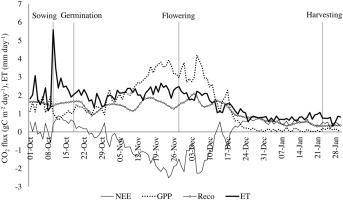Field Crops Research ( IF 5.6 ) Pub Date : 2021-10-04 , DOI: 10.1016/j.fcr.2021.108307 Abhishek Chakraborty 1 , Karun Kumar Choudhary 1 , P. Srikanth 1 , K.V. Ramana 1 , M.V.R. Seshasai 1 , K. Narayanarao 2 , A. Amaregouda 2 , Yogendra Yadav 3 , G. Annapurna 1

|
Present study is the first to report the ecosystem CO2, H2O and energy exchanges (at diurnal, daily and seasonal-scale) from rainfed winter chickpea crop (Cicer arietinum L.), grown under residual soil moisture over semi-arid peninsular India, using eddy covariance system. The available energy to the ecosystem was found to be predominantly partitioned into sensible heat flux (H), except during the peak vegetative stage. Asymmetric response of the daytime (forenoon and afternoon) CO2 and energy fluxes were observed due to limited soil moisture condition. The peak vegetative stage of the crop i.e., 40–60 Days after Sowing (DAS) showed highest rate of Net Ecosystem CO2 Exchange (NEE; −9 to −11 μmol m−2 s−1) and Latent Heat Flux (LE; ∼ 300 W m−2). The response of daytime Gross Primary Production (GPP) to light intensity was found to be poor during 1–16 DAS, improved steadily in 17−34 DAS, remained high in 35–69 DAS, and deteriorated thereafter till harvesting (70–106 DAS). The chickpea crop was net CO2 sink on daily basis during 17–69 DAS. Peak daily NEE of −2.52 gC m−2 day−1, GPP of 4.2 gC m−2 day-1 and Evapotranspiration (ET) of 2.38 mm day−1 were observed during the growing season. Over the entire season, rainfed chickpea was found to be a weak carbon sink with cumulative NEE of -32.39 ± 4.21 gC m−2; GPP of 163.03 ± 15.04 gC m−2; Ecosystem Respiration (Reco) of 127.45 ± 12.85 gC m−2; ET of 177 ± 18.13 mm. The maximum ecosystem water use efficiency (GPP/ET) and crop coefficient were found to be 1.7 gC m−2 mm−1 and 0.6 respectively at peak vegetative stage, which are sub-optimal compared to well managed chickpea crop. The results help us to understand the ecosystem processes and exchanges from rainfed winter legume-based cropping system, which intern would significantly contribute in global carbon and moisture budget.
中文翻译:

使用涡流协方差技术在雨养印度半岛残留土壤水分条件下生长的鹰嘴豆作物的 CO2、H2O 和能量通量
本研究首次报告了在半干旱半岛上残留土壤水分下生长的雨养冬季鹰嘴豆作物 ( Cicer arietinum L.)的生态系统 CO 2、H 2 O 和能量交换(在昼夜、每日和季节性范围内)印度,使用涡流协方差系统。发现生态系统的可用能量主要分配为显热通量 (H),除了在高峰营养阶段。由于土壤水分条件有限,观察到白天(上午和下午)CO 2和能量通量的不对称响应。作物的营养高峰期,即播种后 40-60 天 (DAS) 显示出最高的净生态系统 CO 2交换率 (NEE;-9 至 -11 μmol m-2 s -1 ) 和潜热通量 (LE; ∼ 300 W m -2 )。发现白天初级生产总值 (GPP) 对光照强度的响应在 1-16 DAS 期间较差,在 17-34 DAS 中稳步改善,在 35-69 DAS 中保持高位,此后恶化直至收获(70-106 DAS )。在 17-69 DAS 期间,鹰嘴豆作物每天都是净 CO 2汇。在生长季节观察到峰值每日NEE为-2.52 gC m -2 day -1,GPP为4.2 gC m -2 day -1和蒸散量(ET)为2.38 mm day -1。在整个季节,雨养鹰嘴豆被发现是一个弱碳汇,累积 NEE 为 -32.39 ± 4.21 gC m -2; GPP 为 163.03 ± 15.04 gC m -2;生态系统呼吸 (R eco ) 为 127.45 ± 12.85 gC m -2;ET 为 177 ± 18.13 毫米。发现最大生态系统水分利用效率 (GPP/ET) 和作物系数在营养高峰期分别为1.7 gC m -2 mm -1和 0.6,与管理良好的鹰嘴豆作物相比,这是次优的。结果有助于我们了解以雨养冬季豆类为基础的种植系统的生态系统过程和交换,该系统将对全球碳和水分收支作出重大贡献。











































 京公网安备 11010802027423号
京公网安备 11010802027423号